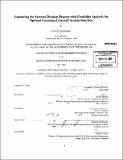Enhancing the systems decision process with flexibility analysis for optimal unmanned aircraft system selection
Author(s)
Bachmann, Chris H., III (Christopher Henry)
DownloadFull printable version (37.12Mb)
Other Contributors
Massachusetts Institute of Technology. Engineering Systems Division.
Advisor
Owen L. Deutsch.
Terms of use
Metadata
Show full item recordAbstract
Systems Engineers often conduct decision analysis in order to provide decision makers with a quantifiable means to make decisions. However, the field of Systems Engineering is often criticized for focusing on processes and requirements instead of the actual system. As a result, it limits the decision maker's ability to understand the system's properties and behaviors. This research enhances an existing decision methodology in order to maintain holistic thinking and provide decision makers with measureable information that result in better decisions. This thesis explores commercial, off the shelf systems in order to provide a potential solution to a backpackable, lethal unmanned aircraft system (UAS). It first employs the Systems Decision Process which is a widely applicable decision method that focuses on system function and requirements in order to select an optimal solution. The System Decision Process utilizes the additive value model. The additive value model is a universally accepted quantitative approach for evaluating a candidate solution space in order to determine a best solution. This research then applies Flexibility Analysis in order to enhance the System Decision Process. Flexibility Analysis is a three step process developed by the researcher. The first step involves decomposing and modeling the UAS as a system of systems. The next step introduces the Requirements Flexibility Graph as a structured technique which incorporates stakeholder levels of acceptability along with the engineers' stochastic estimates of a system's changeability with respect to constraints. (cont.) The final step replaces preference weighting in the additive value model with potential value. Potential value is a quantifiable measure of a system's flexibility. It supplies decision makers with information about a system's inherent value and allows them to allocate resources to those system attributes that provide the most value return. Finally, a realized value score informs the decision maker of the resulting value of changing the system from the status quo to a future state.
Description
Thesis (S.M.)--Massachusetts Institute of Technology, Engineering Systems Division, 2008. Cataloged from PDF version of thesis. Includes bibliographical references (p. 185-188).
Date issued
2008Department
Massachusetts Institute of Technology. Engineering Systems DivisionPublisher
Massachusetts Institute of Technology
Keywords
Engineering Systems Division.